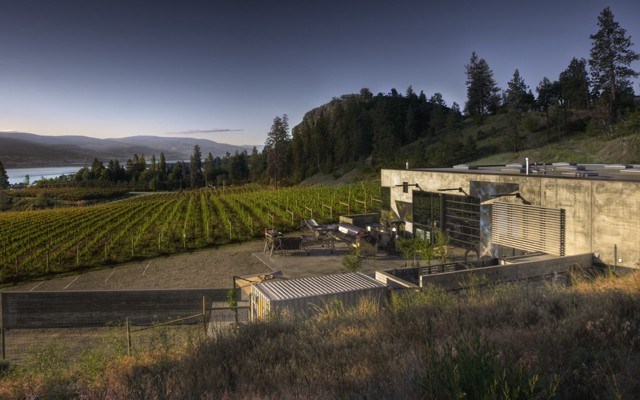The international wine business is one big interconnected web of personalities that typically goes where the wines are or, to be more specific, where the best wine can be made. The same names tend to crop up every decade or two wherever cutting-edge wine comes into play. Two guys making an impact in B.C. at the moment come from far-flung places yet somehow always end up at the most exciting projects.
Luckily, you'll be able to sample the results of a couple of these projects at the upcoming Vancouver International Wine Festival.
Italian Alberto Antonini grew up in Tuscany and runs his family estate, Poggiotondo, in Cerreto Guidi near Florence. He started his career as an assistant winemaker at the Frescobaldi Winery before becoming the technical director at the Col D'Orcia Winery in Montalcino. From Montalcino he went on to become the head winemaker at the Antinori winery before starting his own consulting business in 1997.
Pedro Parra is a wine terroir consultant who lives in Concepcion, Chile. His focus is on understanding the relationship between wine and terroir, and he has spent well over a decade digging holes or pits (calicatas) looking for vine roots all around the world. Parra works mainly in Chile, Argentina and Italy, but he has spent time in Burgundy, Sonoma, Armenia, Uruguay and, more recently, in the Okanagan Valley and on Vancouver Island.
Antonini and Parra have collaborated in the Okanagan, mainly at Haywire Winery and Okanagan Crush Pad, and have been instrumental in the development of Haywire's new cutting-edge project in Summerland's Garnett Valley, where they're working hard on growing pinot noir bio-dynamically on virgin land.
Both Antonini and Parra have also worked with Coolshanagh, a small winery making chardonnay at the north end of the Naramata Bench. They love the soil and the setting, and while they would have preferred a different vineyard layout they are working with Skip and Judy Stothert to make the best chardonnay they can.
Parra is a big pinot noir lover and his work has taken him to the east side of Vancouver Island and Blue Grouse Vineyards where he consults to owner Paul Brunner and winemaker Bailey Williamson. Brunner told me he is committed to the long term. Parra will be a good part of that as Blue Grouse moves forward.
The connections continue this month at the Vancouver International Wine Festival when Bodega Garzon, an Uruguayan winery, makes its Vancouver debut. The Garzon project is a gigantic undertaking put together by a team of people led by Argentine oilman Alejandro Bulgheroni with his long-time friend and Argentine winery owner Carlos Pulenta and Alberto Antonini and Pedro Parra. Bodega Garzon is like no other winery project I know.
The winemaking and the viticulture is Antonini's vision with advice from Parra, whose calicatas were instrumental in pinpointing the position, vines and rootstocks that went into the ground. In all, they laid out a 200-hectare vineyard in 1,000 individual blocks, spreading them far and wide across the stony hillsides. In between the blocks, extensive swaths of bio-diversity were left to give the property a very Tuscan mixed-farming look.
Antonini opted to bring in French tannat clones from Madiran in southwest France rather than using those available locally. Early results would suggest he made the right decision.
"We decided to have a focus on grapes," he says. "Tannat was here forever and the most important grape. Albariño seemed a good possibility because the site not far off the south Atlantic Ocean has lot of similarity with the albariño lands of Galicia in the North Atlantic."
The winery, built to the highest LEED certification, is a vast expanse of concrete and large wooden foudres mostly tucked below the surface of the land. Those who know Antonini know that he loves concrete because "it provides an environment for any living organism to survive in. It's where all the microbiology that we want lives, and we want to welcome them."
Garzon started with barrels for aging but they quickly realised it wasn't the best tool for the fruit. Today, the cellar is filling up with large, untoasted casks or foudres, to protect the original flavours and aromatics of the fruit.
"It's nothing new we are just going back to the early days of winemaking," he says.
Intrigued? On the other side of the tasting room in the "Canada" section, Haywire Winery will pour one of the most interesting pinot gris made anywhere in the world — Haywire Switchback Organic Vineyard Pinot Gris 2015, a wine inspired by Antonini and made by winemaker Matt Dumayne and the team at Haywire. The organic fruit is fermented in concrete eggs — a modern day interpretation of the Old World concrete tanks that line the cellars of old and, lately, new European wineries.
Both Antonini and Parra are terroir guys and that means gaining knowledge about the sites you grow grapes upon is essential. The challenge is that in places like the Okanagan Valley or the Cowichan, or even in Punt del Este in Uruguay, there's no accumulated bank of knowledge, no century of trial-and-error farming to fall back on. Both agree the New World has terroir, it's just a matter of perseverance and, of course, looking for it in all the right places.
You can start your terroir journey at the 39th Vancouver International Wine Festival, February 11 to 19. For tickets and event information go to www.vanwinefest.ca.
See you in the room.
Anthony Gismondi is a globetrotting wine writer who makes his home in West Vancouver, British Columbia. For more of his thoughts on wine log onto www.gismondionwine.com.




